Critical Spectatorship, Violent Care
This is a pre-print of the essay that will be included in Robert Dörre, Christoph Günther, and Simone Pfeifer (eds.), Disentangling Jihad, Political Violence, and Media. Edinburgh: Edinburgh University Press, 2023 (forthcoming). We thank the author, the editors and the publisher for their permission and collaboration. TH/HaFI
You are in a giant white room. You have no memory of how you got here, but you sense that this place is not yours. Nothing around you is familiar. All that seems to belong to you is your look. So you look.
You see people walking slowly around you, looking at all that is around you. Filling the center of the room is a large array of publications and images: eighteenth-century posters of Arabs beheading colonial explorers; twenty-first-century Islamist militants presented with menacing dark faces on Western news magazines, and other materials representing how Arabs and Muslims have been depicted in Western printed media. These images face you. They define your space.
Absorbed by these images, the people walk among them as if in a trance. They don’t seem to notice you. You notice there is glass encasing you, as if rendering you invisible to them. In the glass, you see yourself reflected. You see that you are a head without a body. You don’t resemble any of the images around you. You look like a relic made of stone, except your surface texture seems closer to plastic. You look like an object that one would expect to find in a museum, which seems to be where you are. Maybe it is for this reason that no one pays attention to you.
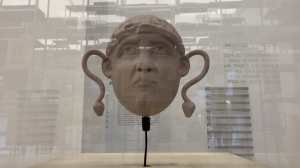 Morehshin Allahyari, Material Speculation Dead Drops: Medusa Head. Photographed in the Kunsthalle Mannheim exhibition MINDBOMBS.
Morehshin Allahyari, Material Speculation Dead Drops: Medusa Head. Photographed in the Kunsthalle Mannheim exhibition MINDBOMBS.
There are those who try to make you seen. One person leads a group to you. She identifies you as a replica of a Medusa head from the South Ivan region of what is now Iraq. The original Medusa head was created 2000 years ago in the city of Hatra during the Parthian Empire. It watched over the ancient city until 2016, when ISIS militant fighters shot it to pieces and circulated its destruction as a viral video, causing a media sensation. Later that year, an artist named Morehshin Allahyari took that footage and used it as the basis to create a 3D model of you. The 3D model was then printed, and it became you. You are here to represent the triumph of artists over the violence of political extremism, and how the iconoclasm of ISIS can be countered.
Moments later, another person leads another group, and provides a more elaborate explanation for what you are doing here. He identifies you as Medusa, so that he can introduce the Medusa Effect: the condition of when a spectator is petrified by their own act of looking, just as in Greek mythological tales when those who saw Medusa would be petrified. This, he states, can also describe what happens to those who encounter terrorist violence in the media, when their gaze produces a state of paralysis. This thematic significance gives a justification for your presence among these more disturbing images.
You are a Medusa, but no one who looks at you is petrified. Quite the opposite, they don’t seem disturbed by you in any way, compared to the more sensational images around you. Is it because your presence is too contained in abstract symbolism to register as real? Medusa was defeated when her face was reflected in Perseus’ shield, separating her presence from its deadly power. It seems that your existence as a digitally mediated replica of a 2000 year old representation, now hermetically sealed not only in glass, but by the academic attributions of curators and tour guides, has rendered you into a harmless reflection.
And now, is there a way for me to see you beyond my own reflections upon you, in order to behold your power?
———
I wrote the above text following an October 2021 visit to MINDBOMBS, an exhibition at the Kunsthalle Mannheim. The exhibition presented artworks relating to the history and political iconography of modern extremist violence, from the eighteenth-century French Revolution to contemporary leftist, right-wing and Islamist movements. In a German news radio interview, curator Sebastian Baden expressed his intentions for the exhibition: ‘When it comes to political violence, we want to show that the complexities behind it are really multifaceted and you always have to illuminate different perspectives.’ Baden elaborated that the exhibition played a uniquely pedagogical role in providing the public with a safe, curated environment to engage critically with extremist images. ‘You learn to read in school, but looking at pictures is the job of the museum.’
The question of how to look at extremist media also motivated the production of Bottled Songs 1–4 (2020), a series of videos that I co-authored with Chloé Galibert-Laîné, that was included in the exhibition. While it was an honor for our work to be included in such a bold curatorial proposition, for some time I had been harboring doubts concerning a few of the ideological and methodological underpinnings of the project, which the presentation of our work in a museum context brought into view.
We initiated the Bottled Songs project in 2016 to employ a method of critical spectatorship towards ISIS propaganda videos. This method was derived from our shared background producing online video essays that reappropriate existing works of media to produce critical insights reflecting upon that same media. Having made video essays mostly on works of cinema, we sought to apply this form to reflect on the phenomenon of ISIS media that was dominating US and European media discourse at the time. At the start of the project, neither of us claimed expertise on ISIS or online extremist media. In a statement that accompanies the series, we account for our position: ‘We wanted to dissect the aura around these videos, in the hope that exposing our own spectatorial mechanisms could help others make sense of their own responses to online media terror.’
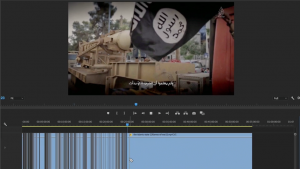 Reconstructing the editing procedures of ISIS. Still from Bottled Songs: Looking Into the Flames.
Reconstructing the editing procedures of ISIS. Still from Bottled Songs: Looking Into the Flames.
Critical to this aim was our use of desktop documentary, a method of filmmaking in which the film takes place primarily within a computer screen. This method seemed especially suitable for documenting our online encounters with ISIS media as an internet user without a professional research background in the material might experience. The ubiquity and familiarity of the desktop environment presents a new form of cinematic first-person perspective by linking the viewer’s gaze with the author’s desktop, leading the viewer through windows, files, and other materials on the screen. This phenomenon, which we have elsewhere termed ‘desktop subjectivity,’ immerses the viewer in a desktop space that normally is exclusively accessible to its owner; this sensation of privileged access which can create an intense spectatorial sensation of intimacy and disclosure. In Bottled Songs, the narration of subjective experience through the desktop is meant to produce a state of critical spectatorship, interrogating the ways that subjective experience is shaped through the desktop interface. As Galibert-Laîné has written, ‘[w]hen I say “I” in the video, it isn’t so much about “Chloé Galibert-Laîné” as a biographical entity as it is about whoever recognize[s] herself in that “I”. Adopting the first-person is a way to guide the viewer into thinking reflexively and critically about her own act of watching.”[1]
However, over time we realised that our production of critical subjectivity afforded by the desktop documentary approach is problematised by the power relations encoded in desktop subjectivity. We tried to account for them in our statement accompanying Bottled Songs 1–4: ‘As two Western researchers operating within an online vantage point… we are aware of the systemic privilege that enables our perspectives to be considered in the first place. We cannot speak for others affected by these media, but acknowledge that this material affects countless others deserving to be heard. Chief among them are those persons whose harm and suffering are depicted in these videos, which our work cannot possibly redeem.’ To what extent were our first person accounts of watching ISIS propaganda insufficiently addressing or failing to serve those who were most harmed by them? What bearing did our work have on those who had been directly and physically harmed by the violence of the Islamic State, or those who risked being harmed by the perpetuation of ISIS media and the negative associations it projects upon Muslim peoples and cultures?
These questions were vividly palpable during a tour of the MINDBOMBS exhibition, given to a conference of scholars on political extremism and media violence in the Islamic context, which I and most of the contributors to this volume attended. One of the scholars approached me, visibly disturbed, to tell me that he had watched a section of Bottled Songs that examined the social media and online traces of a young French ISIS militant. He informed me that he personally knew the militant’s family and was deeply troubled that this video would perpetuate his identity as a militant. One moment that he found particularly disturbing was the appearance of his deceased body on a German right wing website. We included this moment to show how the militant’s image had become instrumentalised to fuel online hatred, but the scholar’s objections now made us reflect on another instrumentalisation taking place in our midst, in which we were implicated. This connected to another of his objections: that he was especially troubled to find these images in a museum, playing on a giant projection in a perpetual loop.
What violence is specifically attributable to a museum’s production of visibility? The same video had been available online since 2017, where one of the militant’s family members had seen and endorsed it as a just and empathetic representation of the militant. But upon learning of its placement in a museum, this family member expressed her objections to us; in respect to her wishes, we have withdrawn the video from further circulation in any context. The internet, like a museum, is an archive, a site of preservation for future reference. To consider how a video that was available online for several years without causing objection became offensive as a looped projection in a museum is to consider the politics of the archive: the modes of visibility and status assigned to different contexts of archival access, what value (cultural, economic, ideological) is being produced through their activation, and who possesses agency in determining visibility and value.
What harm was our project unintentionally or inadvertently reinforcing or reproducing, despite, or even because of, our attempts to produce a critical engagement? Such questions arose in the course of making the videos. In the second video from Bottled Songs, Looking Into the Flames, I deconstruct an hour-long ISIS propaganda video in order to understand the workings of its audiovisual rhetoric. In one sequence, I attempt to reverse engineer the ISIS video by putting it into an editing timeline and cutting it into its individual shots. In doing so, I am re-performing the editing of the film, and am left with a loose replica of the editing timeline of the film, similar to what the original creator of the video would have had. Seeing this timeline on my own desktop put me in a very uneasy position of identification of power associated with media production, specifically extremist propaganda. That these uncomfortable dynamics of identification were then retransmitted to my audience created even more ethical unease.
These questions preoccupy me in pursuing the Bottled Songs project beyond its first phase that directly confronted ISIS videos. I am now investigating the ongoing legacy of ISIS propaganda media as digital archival material, and the ‘afterlives’ of this media as it finds its way into new contexts and uses. I am especially interested in how others have used this media to produce forms of critical spectatorship in the face of online extremist propaganda. Besides artists such as Morehshin Allahyari, there are also researchers, educators and security specialists, whose use of archival materials are examined later.
———
I lacked words to describe these dilemmas until I encountered the Medusa head in the Kunsthalle Mannheim. Attached to its base is a USB cable to which anyone can connect with a laptop. Upon doing so, the Medusa head is revealed to be a hard drive containing files that document how its creator, artist Morehshin Allahyari, used ISIS videos and research documents to create 3D printed reproductions of artifacts destroyed by ISIS. Allahyari initially intended to make the documentation of all her reconstructed artifacts freely available as a means to overcome the desecration of Middle Eastern cultural heritage enacted by ISIS violence: ‘The more people 3D-print these, or even keep them as digital files… or read about the history of the artifacts – the more we have collectively resisted the act of forgetting.’
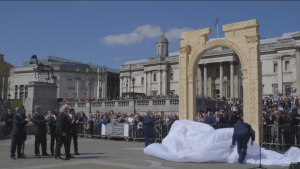 Unveiling of a replica of the Palmyra Arch in London.
Unveiling of a replica of the Palmyra Arch in London.
However, over time Allahyari noticed ‘a huge spike in the act of reconstructing artifacts in Europe and the U.S. in parallel with their destruction in Iraq and Syria.’ She cites the Palmyra Arch, destroyed by ISIS in 2015, reconstructed using 3D modeling technology and unveiled in London’s Trafalgar Square by UK Prime Minister Boris Johnson, who hailed the reconstruction as ‘a triumph of technology and determination… in defiance of the barbarians who destroyed the original.’ Morehshin remarks that Johnson’s statement ignores the historical context of colonial and imperial violence inflicted by the West on the Middle East, such as the 2003 US and European invasion of Iraq that contributed to the rise of ISIS. The transference of the Palmyra Arch from its original site in Syria to central London highlights the role of digital technology in transferring cultural heritage from the Middle East to the West, a phenomenon Allahyari has termed ‘digital colonialism.’ Reflecting further on how an ostensibly humanitarian effort of cultural restoration perpetuates the violence of cultural dispossession, Allahyari offers another term to describe the instrumentalisation of goodwill and empathy. She writes, ‘[f]or any Western institution to focus on the reconstruction of the rare and special while other Western institutions have wrought the destruction of the everyday, is violent care.’
Does Allahyari’s critique of digital colonialism express concern over the risk of violent care in her own digital restoration of the Medusa and other destroyed artifacts? Allahyari has kept her production files private, waiting for the right circumstances to entrust them to a museum or cultural institution in the Middle East. Realising that the project had entered a state of partial withdrawal, I was both puzzled and grateful that I could stand before the Medusa head in the Kunsthalle Mannheim, a situation made possible with Allahyari’s consent. Having access to the history and struggle contained within the head, it addresses me like no other work in the exhibition. I start to imagine a voice associated with this head, and ask how this voice could tell its own story. In what language would it speak, what accent would it have? How deep or light, female or non-gendered would it sound? As I speculate on a question impossible to answer, other visitors pass by, unaware of the deeper implications of this head and its presence in this exhibition.
This situation could describe a state of what Edouard Glissant termed opacity, the ethics of unknowability, the right not to be seen. It is a strategy that has become more present in the continuation of the Bottled Songs project, as I have fallen away from direct analysis and representation of ISIS media to avoid retransmitting harmful effects associated with its images. To what extent does this opacity support or obstruct the operations of the museum exhibition, to equip its visitors with tools to critically engage with political violence?
For this reason I secured permission from the museum to film the Medusa head, though I was advised that I couldn’t film any of the museum visitors to preserve their right to privacy. I started to imagine what it would look like to have scenes in the museum with every face rendered into a cloud of illegible pixels. How ironic if the only face exposed in the museum scene would be that of Medusa.
———
Like no other work in the exhibition, the Medusa head drew your attention precisely because it was one of the most overlooked works among the museum visitors, its significance to the theme of the exhibition not plainly visible. It reminded you of a scene from Images of the World and the Inscription of War (1988), an essay film by Harun Farocki, that reflects extensively on the historical relationship between violence and visibility. The film famously muses upon a photograph taken by a US reconnaissance aircraft during World War II that inadvertently revealed the Auschwitz Nazi concentration camp. Despite this discovery, no action was taken. In his related essay Reality Would Have to Begin, Farocki muses, ‘[t]he analysts had no orders to look for the camps, and therefore did not find them.’
The most visible image of Images of the World and the Inscription of War, the one that appears most prominently in online searches for the film, is one that I’ve learned to see differently in recent years. It appears in a sequence in which Farocki sits at a desk before the camera, studying Femmes Algeriennes (Women of Algeria), a book of photographs by Marc Garanger, a French conscript stationed during the French occupation of Algeria in the early 1960s. Garanger was ordered to take photos of Algerian women for identification purposes as colonial subjects of France. Women who normally concealed their faces in daily life were photographed against their will. Their faces were exposed in a mode of colonial violence performed by producing visual data to carry on colonial administrative operations. Despite himself being instrumentalised by the French army in these operations, Garanger smuggled the photographs to Switzerland to be published and circulated as images of protest against the French occupation.
This sequence provokes three questions for you. Can these women’s images of expressions of protest be separated from their expressions directed at Garanger as he trained his lens (however reluctantly) upon these women? Was Garanger’s act of publication a form of violent care, in that it perpetuated and amplified an act of non-consensual image taking? Is it also worth considering that the book’s assembly of these faces visualises a collective protest that wouldn’t have been possible for those individuals in their actual lived conditions?
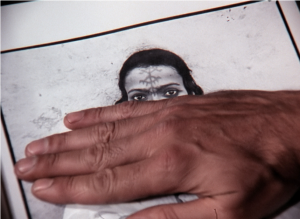 Harun Farocki, still from Images of the World and the Inscription of War.
Harun Farocki, still from Images of the World and the Inscription of War.
In the film, Farocki turns the pages of Garanger’s book, and with every page turned, a different woman’s face is exposed. At one moment, he pauses to place his hand over the lower half of a woman’s face, so that only her eyes remain visible as they normally would be under a veil. The gesture seems to recover the woman, in multiple senses of the word – to re-cover her face in order to recover her claim to her own image.
When you first saw this image, you were struck by the brilliance of this gesture as a mode of critical analysis performed by the body. With a simple move of one’s hand, one can not only study an image, but transform its meaning. It is a perfect example of the Farockian concept of the counter-image, das Gegenbild – an image that opposes another image in order to create a critical awakening. And in this case, one could also attribute this gesture with qualities of empathy and solidarity with the condition of the women in these photos.
When I consider this gesture now, I see a form of violent care. The hand of a male, functioning within the role of a Western researcher, performing a gesture of privilege and power over an image and the human being, the woman, represented by it. In this respect, the poetic gesture re-performs the violence over she who is captured in the image. Even if intended as a poetic gesture of resistance against the Western Colonialist gaze, it cannot quite overcome the institutional framework of the Western gaze and the implicit harm carried within it.
My own Western gaze seeks another view of this scene, not to justify Farocki’s method, but to reaffirm the value of a counter-image, if it might even be utilized to critique its own author. In this instance, the counter-image is produced not through an alternative image, but an alternative way of looking at the existing image. Looking at this image now, informed by the visual culture of colonialism and violent care, what changes for me is that I am disinvested in Western agents such as Farocki or Granger as producers and critical mediators of the image of the Algerian woman. Instead I reinvest myself in the woman as central to determining the significance of her image. Her agency, her selfhood, becomes more legible to me, even if it remains woefully under-articulated. Above all, the question: who can really speak on her behalf? The archival value of this image hinges upon this question.
This came to your mind when encountering the Medusa head at the MINDBOMBS exhibition. You thought of a woman spoken of through an image taken against her will, then interpreted by another’s hand. You thought of a head destroyed and digitally recreated in defiance of the forces of destruction, only for that effort to risk feeding back into a cycle of power and violence. You thought of the mythical being represented by the head: Medusa, a woman who was raped by a god whose wife then took vengeance on her, transforming her beauty into monstrosity: selfhood stolen twice over.
This led me to write the passage at the beginning of the essay. Asking myself how to speak of the Medusa head, I was interested neither in a first person mode of address that privileged my own subjective position over the head, or in a third person that conveyed a pretense of objective description. To address the Medusa head in the second person, I could simultaneously address my reader through my ‘you’ as a way to collapse the distance between these two audiences. In this way, I could re-embody the viewer in the subjectivity of the Medusa head.
At least this is what, in most moments, you would like to believe.
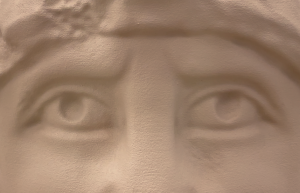
[1] https://desistfilm.com/interview-chloe-galibert-laine/
Kevin B. Lee/strong> is the Locarno Film Festival Professor for the Future of Cinema and the Audiovisual Arts at USI Università della Svizzera italiana. A filmmaker, media artist, and critic, he has produced over 360 video essays exploring film and media. His award-winning Transformers: The Premake introduced the “desktop documentary” format and was named one of the best documentaries of 2014 by Sight & Sound. His video essays Reading // Binging // Benning and Once Upon a Screen: Explosive Paradox received the most mentions respectively in the 2017 and 2020 Sight & Sound video essay polls. Through Bottled Songs, his collaborative project with Chloé Galibert-Laîné, he was awarded the 2018 Sundance Institute Art of Nonfiction Grant, the 2018 European Media Artist Platform Residency, and the 2019 Eurimages Lab Project Award at Karlovy Vary International Film Festival. In 2020 he co-curated the Black Lives Matter Video Essay Playlist with Will DiGravio and Cydnii Wilde Harris. Previously he was Professor of Crossmedia Publishing and co-director of the Masters Program in Artistic Research at Merz Akademie, Stuttgart. In 2016 he was the first fellow in the residency program of the Harun Farocki Institut.
September 21st, 2022 — Rosa Mercedes / 06